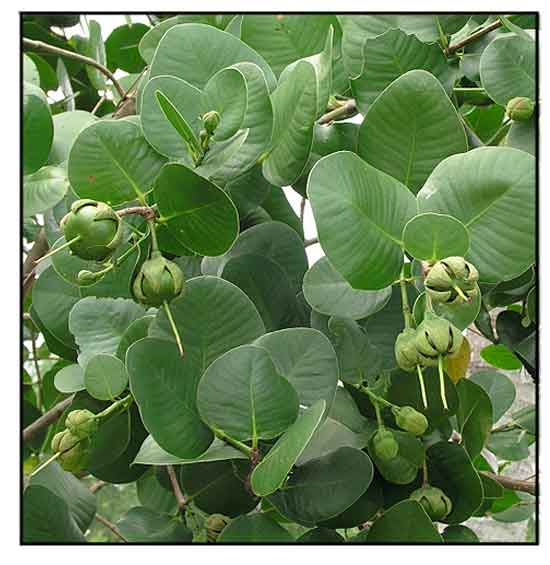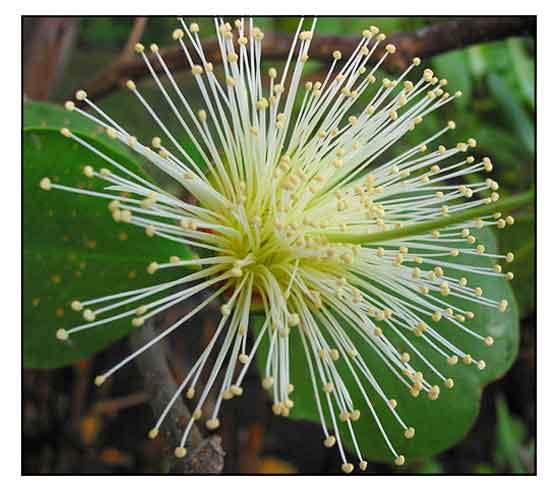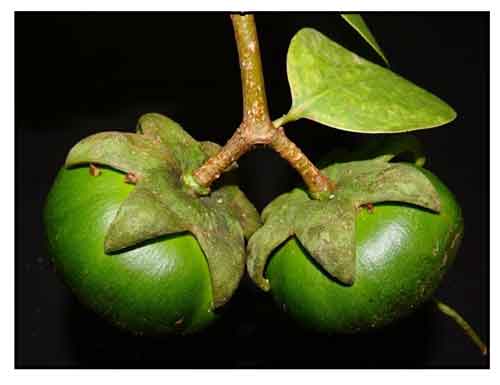 Gen info Gen info
- Sonneratia ovata is a mangrove tree in the family Lythraceae.
- Formerly the Sonneratia were place in the family Sonneratiaceae, which included both the Sonneratia and the Buabanga, but the two are now placed in their own monotypic subfamilies of the family Lythraceae.
(8)
- Locally known as pagatpat baye in Siquijor and pagatpat (a shared common name with S. caseolaris) in Bohol, It was first sighted in Liloan, Maria, Siquijor in 1990 (Yao 1997), where a small stand of the species was observed in a lagoon, about 50 meters from the highest tide. It has been reported in Paw, Masbate, Masbate and Basey, Samar. (7)
-
Etymology: The genus name Sonneratia is a Latinized word commemorating Pierre Sonnerat (1749-1841), a French botanist and explorer. The species epithet ovata is Latin, meaning 'egg-shaped' or 'oval', referring to the shape of the leaf blades. (3)
 Botany Botany
• Growth form: A tree up to 20 m tall, with up to 0.2 m tall upright, breathing roots (pneumatophores) at its base. Roots: Upright breathing roots (pneumatophores) are up to 0.2 m tall. Foliage: Opposite, shortly-stalked leaves have leaf blades that are shiny dark green, usually broadly egg-shaped to nearly circular, and 4–10 by 3–9 cm. Flowers: Apetalous flowers are found singly or up to 3 together, with the interiors of its sepals tinged red. Its flowers open at dusk, giving off a smell of sour milk, and last for one night. Fruits: Its green fruits are somewhat pear-shaped berries, 3–4.8 cm wide, and contain many seeds. Its buoyant, water-dispersed seeds are tiny, white, flattened, and embedded in the fruit’s fleshy pulp. (3)
• Sonneratia ovata grows up to 20 metres (70 ft) tall with a trunk diameter of up to 20 centimeters (8 in). The gray bark is smooth to fissured bark. The calyx is cup-shaped with its inner surface reddish at the base. The fruits, dark green when young and ripening to yellowish green, measure up to 7 cm (3 in) long. (7)
Distribution
- Native to the Philippines. (1)
- Found in Batangas and Leyte. Locally numerous, but on the whole, rather rare. (1)
- Also native to Andaman Is., Borneo, Cambodia, Hainan, Jawa, Malaya, Maluku, New Guinea, Solomon Is., Sulawesi, Thailand, Vietnam. (2)
- Found on tidal river banks and on muddy soils subject to tides.
- Ornamental cultivation.
 Constituents. Constituents.
- Study of Sonneratia ovata fruit yielded seven compounds, which included: (-)-(R)-nyasol (1), (-)-(R_-4'-O-methylnuyasol (2) and maslinic acid. (see study below) (4)
- Study of stem bark yielded ß-sitosterol, stigmasterol, and 3ß-acetoxy-lup-20(29)-en-2α-ol. (see study below) (9)
- Study of leaves isolated 23 compounds including four new compounds, namely: three new phenolics, sonnerphenolic A (1), sonnerphenolic B (2), and sonnerphenolic C (23), a new cerebroside, sonnercerebroside (3) together with nineteen known compounds, including nine lignans (5–13), two steroids (14, 15), two triterpenoids (16, 17), three gallic acid derivatives (18–20), two phenolic derivatives (4, 22) and a 1-O-benzyl-b-D-glucopyranose (21) isolated from the leaves of Sonneratia ovata. The other compounds were identified as (-)-(R)-nyasol (4), (7S,8R)-dehydroconiferyl alcohol (5), (7S,8R)-5-methoxydehydroconiferyl alcohol (6), (7S,8R)-urolignoside (7), lingueresinol (8), (+)-isolarici-resinol (9), (+)-isolariciresinol 90 -O-b-D-glucopyranoside (10), (-)-isolariciresinol 9'-O-ß-D-glucopyranoside (11), (-)-episyringaresinol (12), (+)-syringaresinol (13), ß-sitosterol (14), 3-O-palmitoyl-ß-sitosterol (15), corosolic acid (16), 3-O-acetylursolic acid (17), 6-O-galloyl-D-glucopyranose (18), gallic acid 3-O-b-D-glucopyranoside (19), 1-O-benzyl-6-O-galloyl-b-D-glucopyranose (20),1-O-benzyl-b-D-glucopyranose (21), and (-)-rhodolatouchol (22). (see study below) (11)
Properties
- Studies have suggested antioxidant, cytotoxic, antidiabetic, α-glucosidase inhibitory, anticancer, acetylcholinesterase inhibitory, antimicrobial properties.
Parts used
Fruits, stem bark.
 Uses Uses
Edibility
- Mature sour fruits are edible.
Folkloric
- No reported folkloric medicinal use in the Philippines.
- Fruit is used as poultice to treat sprains. Fruit's fermented juice used to test for hemorrhages. (3)
Others
- Wood / fuel: Timber is of limited value; used as fuel.
- Bark: Contains small amount of tannin with commercial use.
- Agroforestry: Planted in coastal areas to control erosion of tidal river banks. (3)
Studies
• Polyphenol Release from Films Supplemented with S. ovata and Piper betel Essential Oil / Antioxidant and Antibacterial Packaging Films: Active food packaging films produced by polymers and polyphenols not only provided water- and UV-barrier properties but also antioxidant and antimicrobial functions to protect packed food during storage. Study evaluated the delivery kinetics of polyphenols from active films based of polyvinyl alcohol (PVOH) and chitosan (CS) enriched with Sonneratia ovata extract (SOE) and Piper betel L. essential oil (PBLO) in different food stimulants. SO extract enhanced thermal and physical behavior of PVOH/chitosan film. Co-addition of Piper betel essential oil reinforces antioxidant and antibacterial functions of resulting films. SOE-added PCs film divulges slower release of polyphenols than films co-enriched with PBLO. The release behavior of polyphenols from active films is controlled by diffusion mechanism. (5)
• Cytotoxicity / Fruits: Study of Sonneratia ovata fruit yielded seven compounds. All the isolated compounds were screened against a rat glioma C-6 cell line using MTT assay. Only compounds (-)-(R)-nyasol (1), (-)-(R)-4'-O-methylnuyasol (2) and maslinic acid showed moderate cytotoxic activity. (4)
• Antioxidant / Stem Bark: Study evaluated the antioxidant activity of stem bark of S. ovata. A methanolic extract exhibited highest in vitro antioxidant activity with IC50s of 4.73 µg/mL and 2.00 µg/ML for DPPH and ABTS free radical scavenging respectively. (see constituents above) (9)
• Alpha-Glucosidase Inhibitory / Fruit: Study evaluated the antidiabetic activity of fruit samples of Kedabu by measuring inhibition of α-glucosidase enzyme in vitro. Acarbose was used as positive control. The EE showed an IC50 of 1.86 µg/mL, while the water and EA fractions showed IC50s of 2.29 and 2.32 µg/mL respectively. Results showed the ethanol extract of fruit has potential as inhibitor of α-glucosidase enzyme, followed by water fraction and ethyl acetate fraction. (10)
• Cytotoxicity / Acetylcholinesterase Inhibitory / Leaves: Study of leaves isolated 22 compounds, including three new phenolics, along with 19 known compounds, including 9 lignans, 2 steroids, two triterpenoids, three gallic acid derivatives, two phenolic derivatives, and a 1-O-benzyl-ß-D-glucopyranose. Compounds 5, 6, and 23 exhibited cytotoxicity against MCF-7 cell line with IC50 values of 146.9, 114.5, and 112.8 µM, respectively, while showing no toxicity with normal cell (PHF) with IC50 >277 µM. Among tested compounds, (S)-rhodolatouchol (22) showed inhibition against AChE with IC50 of 96.1 µM. (see constituents above) (11)
• Potential for Wine Production / Fruit: The ripe mangrove apple is a potential source of natural antioxidants. Phytochemical analysis of fruit extract yielded carbohydrate, protein, flavonoid, and phenolic compounds. Study evaluated the wine fermentation from mangrove apple fruit focusing on variables of sugar supplementation, inoculum size, fermentation temperature and time, wine quality (% v/v alcohol and g/l titratable acidity) and sensory score. Results suggest primary fermentation with 12% sugar ration, 0.25% Saccharomyces cerevisiae inoculum at temperature of 30.0°C in 15 days. Results suggest mangrove apple wine can be considered a healthy source of antioxidants and phenolics ideal for daily consumption. (12)
• Antimicrobial / Stem Bark: Study evaluated the methanol extract of stem bark for antimicrobial activity. The ME of S. ovata stem bark showed high potential as antimicrobial against gram(+) bacteria, Staphylococcus aureus, with IC50 of 7.7, higher than positive control Ampicillin with 37.8 µg/ml. Stigmasterol was one of the major compound isolated from the ME stem bark. (13)
Availability
Wild-crafted.
Ornamental cultivation.
|

![]()







